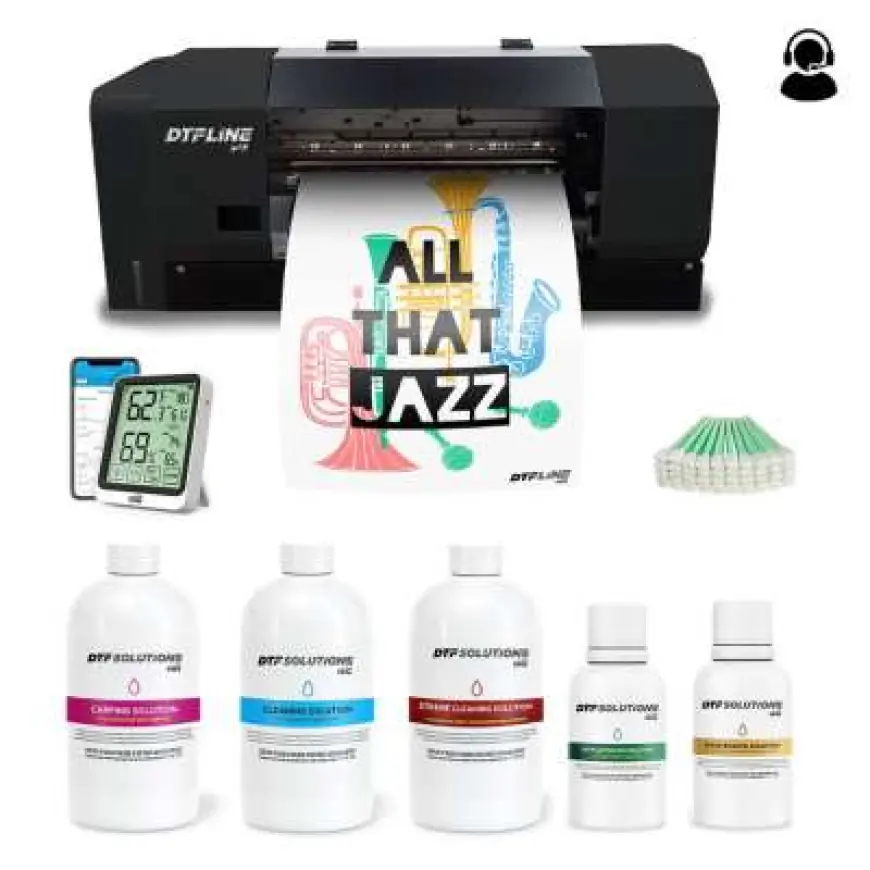A Deep Dive into DTF Printer Maintenance: Tips for Long-Lasting Performance
Direct-to-Film (DTF) printers have emerged as a game-changing technology.
In the world of garment decoration,

They offer high-quality, vibrant prints that adhere to a variety of fabrics. However, like any precision equipment, maintaining a DTF printer is essential for consistent output and long-lasting performance. Proper care not only extends the printer’s life but also ensures every print meets professional standards.
This guide takes a deep dive into essential DTF printer maintenance practices that every user—whether a home-based entrepreneur or a large-scale production house—should follow.
1. Understanding the Basics of DTF Printer Functionality
Before diving into maintenance tips, it’s important to understand how a DTF printer operates. The machine uses specialized ink to print on PET film, which is then coated with hot melt powder and heat-pressed onto fabric. This process involves multiple moving parts: printheads, ink tanks, film feeders, heaters, and powder shakers.
Each of these components must work harmoniously. If one part is neglected, it can affect the entire system—leading to misprints, smudging, or even breakdowns.
2. Daily Maintenance Routine
Daily upkeep is vital to prevent clogging and ensure smooth operation.
Clean the Printhead
Ink buildup in printheads is the most common issue with DTF printers. Perform a nozzle check before starting your print job. If lines appear broken or faded, clean the printhead using the printer’s built-in cleaning function or manually with a lint-free cloth and cleaning solution.
Shake the White Ink
White ink is heavier and tends to settle at the bottom, leading to clogging. Shake the white ink cartridge gently for a few seconds before use to keep it well-mixed and maintain print consistency.
Wipe the Capping Station
The capping station keeps the printhead moist and free from debris. Wipe it with a soft cloth to remove any dried ink, especially if you’ve been printing extensively.
Check for Film Misalignment
Misaligned film can cause poor registration and wasted materials. Inspect the rollers and alignment guides daily to ensure the film feeds straight and consistently.
3. Weekly Maintenance Tasks
If you're running frequent print jobs, weekly tasks help maintain stability.
Clean the Ink System
Flush the ink lines and dampers with cleaning fluid to remove any settled pigment or contaminants. Use proper gloves and follow safety instructions while handling cleaning solutions.
Inspect the Powder Shaker
Over time, hot melt powder can accumulate in the shaker system and affect adhesion quality. Clean the shaker tray and sensor area to ensure smooth application.
Check Fans and Heaters
Heaters are essential for drying the ink and melting powder. Dust or debris in fans or heating elements can cause overheating. Use compressed air to clear out dust and make sure airflow is unobstructed.
4. Monthly Preventative Care
Preventative measures taken on a monthly basis can help avoid major breakdowns.
Lubricate Moving Parts
Apply lubricant to the carriage rail, rollers, and other moving parts. This prevents friction that could cause misalignment or unusual noises.
Update Firmware and Software
Check for updates to your printer’s firmware and RIP software. These updates often contain bug fixes, performance enhancements, and new features.
Calibrate for Color Accuracy
Over time, color output can drift. Use calibration tools or color profiles provided by your manufacturer to maintain color consistency.
5. Troubleshooting Common Issues
Even with regular maintenance, issues can still arise. Here are some common problems and how to fix them:
-
Banding or Lines in Prints: Usually caused by clogged nozzles or low ink levels. Run a nozzle check and perform a head cleaning.
-
Inconsistent White Ink Coverage: Indicates ink separation. Shake the ink well and clean the white ink filter.
-
Powder Not Sticking Properly: Check the powder shaker for blockages and ensure the heat press temperature is correct.
-
Film Jams or Skewing: Realign the film path, check for debris in rollers, and ensure film tension is set properly.
6. Storage and Shutdown Tips
When the printer is not in use, especially for long periods:
-
Power Down Correctly: Always shut down using the printer’s menu. Avoid unplugging directly.
-
Seal the Printhead: Apply cleaning solution to the capping station and park the printhead to keep it from drying out.
-
Cover the Printer: Use a dust cover or cloth to keep debris from settling inside.
7. When to Call for Professional Service
If you've tried all troubleshooting steps and issues persist, it may be time to consult a technician. Warning signs include:
-
Repeated clogs that don't resolve with cleaning
-
Unusual noises during operation
-
Firmware errors that prevent startup
Timely professional help can prevent minor issues from becoming costly repairs.
Conclusion
Maintaining a DTF printer isn't just about keeping it running—it's about optimizing it for performance, consistency, and longevity. By following a structured routine of daily, weekly, and monthly maintenance, users can ensure their investment pays off in the long run. Whether you're printing custom t-shirts or running a full-scale apparel business, proactive maintenance will keep your production smooth and your prints flawless.
What's Your Reaction?
 Like
0
Like
0
 Dislike
0
Dislike
0
 Love
0
Love
0
 Funny
0
Funny
0
 Angry
0
Angry
0
 Sad
0
Sad
0
 Wow
0
Wow
0


















































